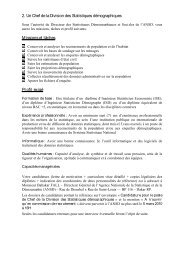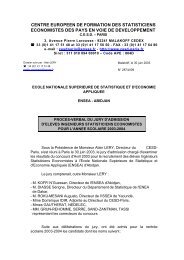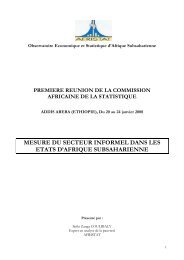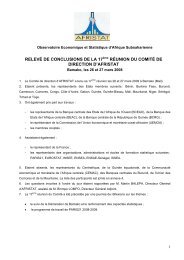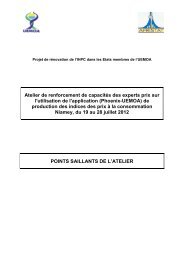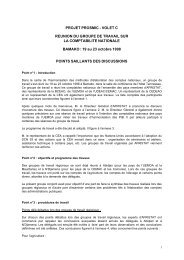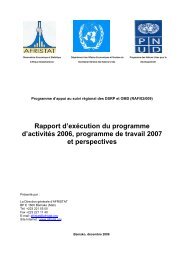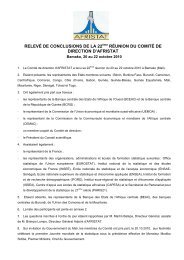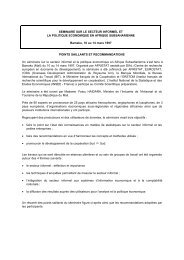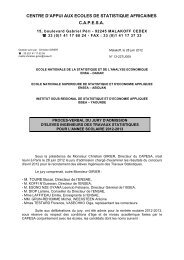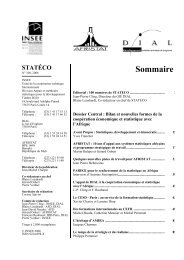Global Purchasing Power Parities and Real Expenditures - Afristat
Global Purchasing Power Parities and Real Expenditures - Afristat
Global Purchasing Power Parities and Real Expenditures - Afristat
Create successful ePaper yourself
Turn your PDF publications into a flip-book with our unique Google optimized e-Paper software.
206 <strong>Global</strong> <strong>Purchasing</strong> <strong>Power</strong> <strong>Parities</strong> <strong>and</strong> <strong>Real</strong> <strong>Expenditures</strong>establishing a regular program of worldwide PPP comparisonsof GDP. Comparisons were organized for 1970, 1973,1975, 1980, 1985, <strong>and</strong> 1993. They covered 10, 16, 34, 60,64, <strong>and</strong> 83 countries, respectively. Responsibility for thesecomparisons was shared by the United Nations StatisticsDivision <strong>and</strong> the University of Pennsylvania. The WorldBank is the current global coordinator of the ICP.Ikle method. An average-price method to compute PPPs<strong>and</strong> real final expenditures above the basic heading. Itentails valuing a matrix of quantities, using a vector ofinternational prices. The vector is obtained by averagingnational prices across participating countries after they havebeen converted to a common currency with PPPs. The Ikleweighting scheme is based on real expenditure structures.The PPPs are obtained by averaging within participatingcountries the ratios of national <strong>and</strong> international pricesweighted by expenditure. The international prices <strong>and</strong> thePPPs are defined by a system of interrelated linear equationsthat require solving simultaneously. The Ikle methodproduces PPPs that are transitive <strong>and</strong> real final expendituresthat are additive. Compared to the GK, the Ikle minimizesthe Gerschenkron effect. Ikle results are considered to bebetter suited to the analysis of price <strong>and</strong> volume structuresacross countries.Imports of goods <strong>and</strong> services. The value (c.i.f.) on importsof goods <strong>and</strong> services.Indirect comparison. A price or volume comparisonbetween two countries made through a third country.For example, in the case of countries A, B, <strong>and</strong> C, the PPPbetween A <strong>and</strong> C is obtained by dividing the PPP betweenA <strong>and</strong> B by the PPP between C <strong>and</strong> B as follows: PPPA/C= PPPA/B / PPPC/B.Individual consumption expenditure by government. Theactual <strong>and</strong> imputed final consumption expenditure incurredby general government on individual goods <strong>and</strong> services.Individual consumption expenditure by households.The actual <strong>and</strong> imputed final consumption expenditureincurred by households on individual goods <strong>and</strong> services;also includes expenditure on individual goods <strong>and</strong> servicessold at prices that are not economically significant.By definition, all final consumption expenditures of householdsare for the benefit of individual households <strong>and</strong> areindividual. Also referred to as “final consumption expenditureof households” <strong>and</strong> “household final consumptionexpenditure.”Individual consumption expenditure by NPISHs. Theactual <strong>and</strong> imputed final consumption expenditure incurredby nonprofit institutions serving households (NPISHs) onindividual goods <strong>and</strong> services. In practice, most final consumptionexpenditures of NPISHs are individual in nature,<strong>and</strong> so, for simplicity, all final consumption expendituresof NPISHs are treated by convention as individual. Alsoreferred to as “final consumption expenditure of NPISHs”<strong>and</strong> “social transfers in kind.”Intermediate consumption. The value of the goods <strong>and</strong> services,other than fixed assets, that are used or consumed asinputs by a process of production.International dollars. The purchasing power parities atthe global level for each economy are computed with theUnited States = 1.00, making it the numeraire currency.These PPP conversion factors transform GDP <strong>and</strong> aggregatesin national currency into a common world currencyreferred to as “real expenditures in the international dollar.”To remove the effect of the U.S. exchange rate, indexes ofreal expenditure per capita at the world = 100 reflect theratio of national real expenditures per capita to the worldaverage real expenditures per capita.Item. A good or service precisely defined for use in priceobservation. A good or service defined by an item specification<strong>and</strong> included on an item list. Countries select the itemsthey price from among the items included on the item list.Also referred to as “product.”Machinery <strong>and</strong> equipment. Includes fabricated metal products,general purpose machinery, special purpose machinery,electrical <strong>and</strong> optical equipment, transport equipment,<strong>and</strong> other manufactured goods.Miscellaneous goods <strong>and</strong> services. Includes expenditureson personal care, personal effects, social protection, insurance,<strong>and</strong> financial <strong>and</strong> other services.



